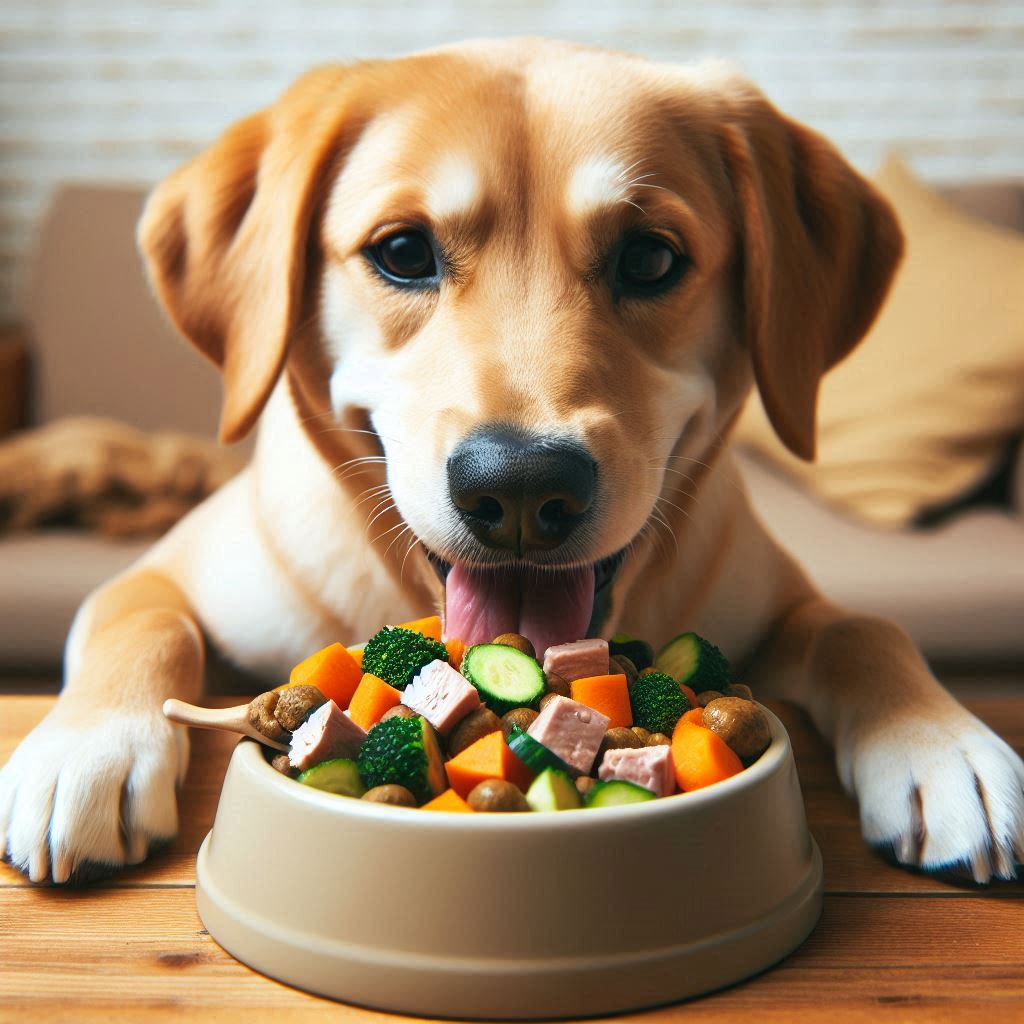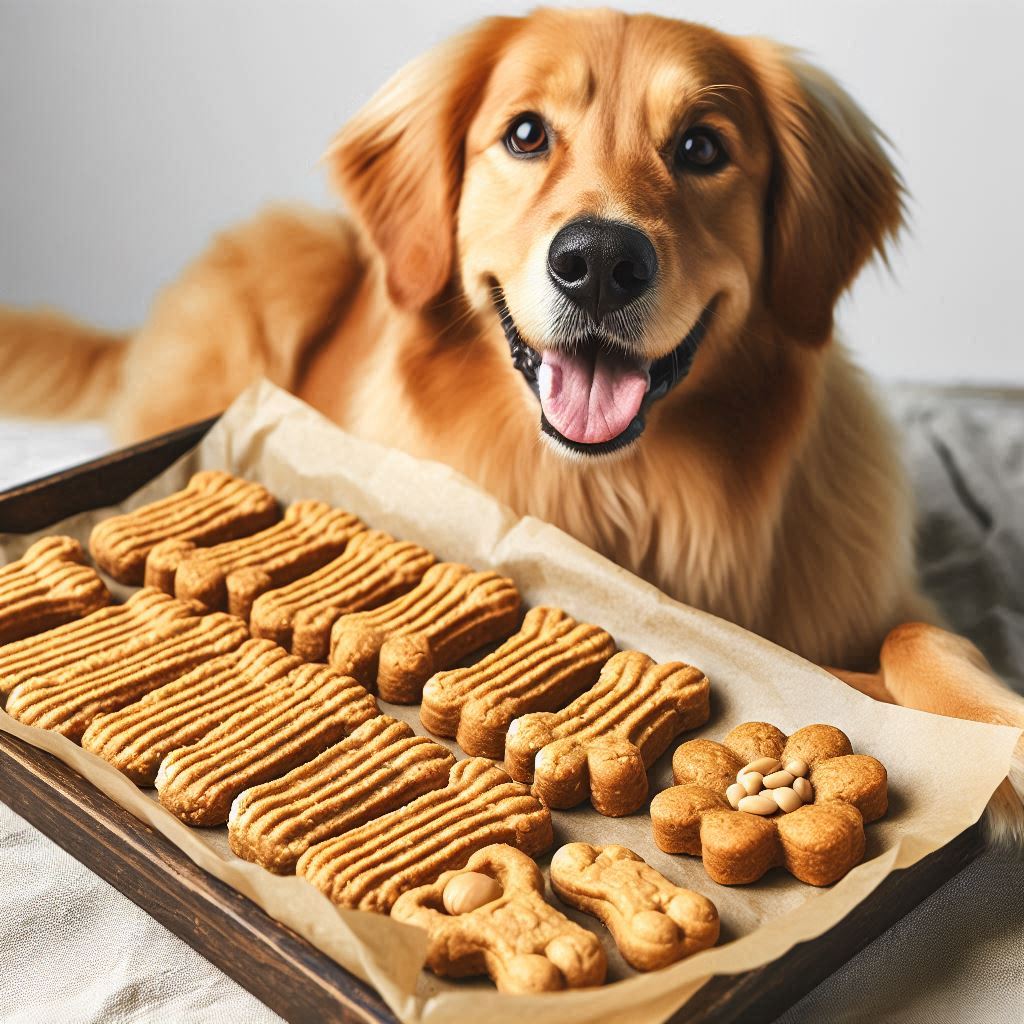About 70% of dog owners are thinking about or already making their pets’ food at home. They want to avoid recalls and feed their pets healthier food. This guide offers tasty homemade dog food recipes and simple meals to keep your dog happy and healthy.
Learn how a homemade diet can benefit your dog. Find out how to switch your dog to homemade food safely. Discover a range of nutritious recipes and snacks made with easy, healthy ingredients. If your dog has a sensitive stomach, you might also be interested in our guide on the best dog foods for dogs with sensitive stomachs.
Key Takeaways
- Homemade dog food recipes can be a cost-effective and budget-friendly substitute for commercial dog food.
- Ingredients like sweet potatoes, lentils, carrots, ground turkey or chicken, and spinach provide essential nutrients for dogs.
- Transitioning your dog to a homemade diet requires gradual changes to prevent stomach upset.
- Consulting a veterinarian is crucial to determine your dog’s individual nutritional needs.
- Homemade dog food can be refrigerated for up to 5 days or frozen for up to 6 months for convenience.
Nutritious Homemade Dog Food Recipe
Making a tasty and healthy homemade dog food recipe is simple. It uses ground turkey, brown rice, frozen veggies, and herbs. This mix makes a balanced and tasty meal for your dog. By preparing your dog’s food, you can make sure they get the right amount of protein, carbs, and important nutrients.

Ingredients
- 1 pound of ground turkey
- 1 large zucchini, grated
- 1 cup of baby spinach, chopped
- 1 cup of shredded carrots
- 1/2 teaspoon of turmeric
- 1 egg
- 3 cups of cooked brown rice
Instructions
- In a large bowl, mix the ground turkey, grated zucchini, chopped spinach, shredded carrots, turmeric, and egg.
- Stir everything until it’s well mixed.
- Put the mix in a baking dish and bake at 325°F for 20-30 minutes. The turkey should be fully cooked.
- Let the food cool down, then add the cooked brown rice.
- Keep the homemade dog food in the fridge for up to 5 days. Or freeze it in portions for later.
This recipe gives your dog a mix of protein, carbs, and important nutrients. It helps keep them healthy and happy. Always talk to your vet to find out how much to feed your dog. This depends on their size and how active they are.
Benefits of Homemade Dog Food
Switching your dog to homemade food can boost their health in many ways. By making their meals yourself, you can ensure they get exactly what they need. This leads to the perks of homemade pet food.
One big plus is controlling the ingredients. You can avoid harmful additives and preservatives in store-bought foods. This means your dog might have fewer allergies and better health.
Homemade food can also make your dog more energetic and healthy. Using fresh, whole foods gives them the right mix of proteins, fats, vitamins, and minerals. This helps them live their best life.
| Benefit | Details |
|---|---|
| Cost-Effective | Making fresh dog food at home can cost around $1.81/lb with the Economy Recipe using the ChefPaw machine, compared to $800-1,000 monthly on storebought fresh pet food for a household with two Labrador Retrievers. |
| Customizable Nutrition | The ChefPaw app offers personalized meal plans for up to five dogs, allowing customized recipes based on factors like weight, breed, and activity level. |
| Time-Saving | The ChefPaw machine takes approximately 40 minutes to make fresh dog food once ingredients are added, saving time and effort in preparation. |
Switching to homemade dog food brings many benefits for your dog. You’ll see better digestion, fewer allergies, more energy, and overall well-being. With the right recipes and tools, you can give your dog a meal that’s good for their health and happiness. If your dog struggles with digestive issues, you might find our recommendations for the best dog foods for dogs with sensitive stomachs helpful alongside these homemade recipes.
Switching to a Homemade Diet

Switching your dog to a homemade diet is a big step. It needs careful planning to make sure your dog gets the right nutrients. Start by slowly adding the new food and watch for any signs your dog might need a diet change.
Signs Your Dog Needs a Diet Change
If your dog has digestive issues, skin problems, or seems tired, it might be time for a diet change. A study in the Journal of the American Veterinary Medical Association found many recipes lack clear instructions. This can lead to harmful food if given for a long time. Watch your dog’s health closely and talk to your vet to find the best diet for them.
- Digestive issues, such as frequent diarrhea or constipation
- Skin problems, including allergies, rashes, or excessive shedding
- Lack of energy or lethargy
- Changes in appetite or weight
Changing to a homemade diet should be done slowly. You might need to work with your vet or a pet nutritionist to make sure the diet is balanced and right for your dog. By paying attention to the signs and making the change carefully, you can help your dog do well on a homemade diet.
Homemade Dog Food Ingredients
When making homemade dog food, picking the right ingredients is key. You want to use high-quality, nutrient-rich items. This includes lean meats, fruits, vegetables, and grains. These items together make a balanced and tasty meal for your dog.
Proteins
Choose lean meats like ground turkey, chicken, or beef for your dog’s diet. These meats are full of amino acids that help muscles grow and keep your dog healthy. Adding organ meats like liver is also good. They are packed with vitamins and minerals.
Vegetables and Fruits
Include dog-safe veggies and fruits in your dog’s food. Options like kale, broccoli, carrots, pumpkin, and blueberries are great. They add antioxidants, fiber, and vitamins to your dog’s diet.
Grains and Carbs
Complex carbs like brown rice, quinoa, or whole grain pasta give your dog energy and fiber. These grains and carbs are great for your dog’s homemade meals.
| Ingredient | Amount | Nutritional Value |
|---|---|---|
| Ground Beef | 2 lbs | High in protein, iron, and B vitamins |
| Calve’s Liver | 1 lb | Rich in vitamin A, iron, and copper |
| Turmeric | 2 tsp | Provides anti-inflammatory and antioxidant benefits |
| Ground Flaxseed | 1/4 cup | Source of omega-3 fatty acids and fiber |
| Kale | 2 cups, chopped | High in vitamins A, C, and K, as well as fiber |
| Broccoli | 2 cups, chopped | Packed with vitamins, minerals, and antioxidants |
| Carrot | 2 cups, shredded | Rich in beta-carotene and fiber |
| Pumpkin | 1 cup, pureed | Provides fiber, vitamins, and digestive support |
| Olive Oil | 2 tbsp | Source of healthy fats and antioxidants |
By picking a mix of lean meats, veggies, fruits, and grains, you can make a homemade dog food that’s both nutritious and tasty. This way, your furry friend gets all the important nutrients they need. For dogs with specific sensitivities, our article on the best dog foods for dogs with sensitive stomachs provides additional options that may complement your homemade meals.
Homemade Dog Treats and Snacks

You can make homemade dog treats and healthy dog snacks at home. Try making peanut butter-based treats or dehydrated sweet potatoes. These natural dog treats are easy to make and your dog will love them.
Our Peanut Butter Oatmeal Dog Treats are a favorite. They need only oats, ripe bananas, and natural peanut butter. Each treat has 40 calories, 5g carbs, 1g protein, and 2g fat.
- Preheat your oven to 350°F and line a baking sheet with parchment paper.
- In a large bowl, mash the ripe bananas until smooth. Stir in the natural peanut butter until well combined.
- Gradually mix in the oats until a dough forms.
- Roll the dough out to about 1/4-inch thickness and use a cookie cutter to cut out shapes.
- Bake the treats for 14-16 minutes, until lightly golden.
- Allow the treats to cool completely before serving or storing.
Store these homemade dog treats in an airtight container. They last up to 1 week at room temperature, 2 weeks in the fridge, or 6 months in the freezer. You’ll get about 40 treats, depending on your cookie cutter size.
| Nutrient | Amount per Treat |
|---|---|
| Calories | 40 |
| Carbohydrates | 5g |
| Protein | 1g |
| Fat | 2g |
| Fiber | 1g |
| Sugar | 1g |
Try using almond butter instead of peanut butter for a twist. These healthy dog snacks are a big hit with dogs!
Storing Homemade Dog Food

Storing homemade dog food right is key to keeping it fresh and safe. The Association of American Feed Control Officials (AAFCO) has 37 guidelines for dogs. These guidelines include specific amounts and ratios for different life stages and needs.
You can keep your prepared meals in the fridge for up to 5 days. Most homemade dog food recipes stay safe in the fridge for three to five days. If you make a lot, store it in a freezer-safe container and freeze for up to 6 months.
To reheat frozen homemade dog food, use the microwave for 15-60 seconds. This gently warms it up. Don’t thaw it at room temperature to avoid bacterial growth. Always label containers or bags with the date to keep track of freshness and use the oldest food first.
- Refrigerate homemade dog food for up to 5 days
- Freeze homemade dog food for up to 6 months
- Thaw frozen food in the fridge, not at room temperature
- Label containers with the date to track freshness
Proper storage of homemade dog food is vital for its nutritional value and safety. By following these tips, you can make sure your dog gets safe and tasty homemade meals every time.
Homemade Dog Food Recipes: Easy Meals for Your Pup
Make mealtime special with tasty and healthy homemade dog food recipes. These recipes use top-quality, natural ingredients. They make sure your dog gets all the nutrients they need for good health.
A favorite recipe of ours is ground turkey, brown rice, and veggies. It has lean ground turkey, brown rice, and fresh veggies like carrots, zucchini, and spinach. Adding a nutrient blend and Omega-3 oils makes it even better for your dog’s health.
If your dog has sensitive stomach or special dietary needs, we have other recipes too. Options include chicken and sweet potato, or beef and quinoa. These recipes use safe, high-quality ingredients for your dog’s meals.
Homemade dog food is easy to make and doesn’t take much time. You can make nutritious meals in your kitchen with simple recipes. Talk to your vet about how much and when to feed your dog. This way, you’ll know you’re giving your dog a healthy, homemade diet.
Check out our homemade dog food recipes, easy dog meals, and dog-friendly recipes. You’ll find everything from classic dishes to new, healthy options. There’s a recipe for every dog’s taste and needs.
Customizing Homemade Dog Food
Every dog is different, so one-size-fits-all dog food doesn’t work. You can make your dog’s food fit their special needs and tastes. You can change the protein sources and add hydrating elements easily.
Hydrating Meals
It’s important to keep your dog hydrated, especially if they have kidney disease. Adding bone broth or goat’s milk to their food helps with moisture and nutrients. These liquids also give vitamins, minerals, and collagen for better health.
When making your dog’s food, try adding one of these liquids. Start with a small amount, like a quarter cup per serving. If your dog likes it, you can add more. Always pick high-quality, safe broths and milks for the best nutrition.
| Ingredient | Benefits | Recommended Inclusion |
|---|---|---|
| Bone Broth | Provides hydration, collagen, and essential nutrients | Up to 25% of the recipe |
| Goat’s Milk | Offers hydration, probiotics, and easy-to-digest proteins | Up to 10% of the recipe |
Adding hydrating elements to your dog’s food makes sure they stay healthy, happy, and hydrated.
Portion Sizes and Feeding Schedule
Finding the right homemade dog food portion sizes and feeding schedule is key for your dog’s health. The right amount of food depends on your dog’s weight, age, and how active they are.
Start by feeding your dog about 1 cup of homemade food for every 10 pounds of their weight. This should be split into 2-3 meals a day. So, a 50-pound dog would need around 5 cups of food, divided into smaller meals.
These are just basic guidelines. The specific amount of food your dog needs can change. Things like breed, metabolism, and health can affect how much and how often you should feed them. Always talk to your vet to find the best feeding plan for your dog.
Watching your dog’s body condition can also help you adjust their food. You can check by feeling their ribs and looking at their waist shape. Keeping your dog at a healthy weight is important. Being overweight can lead to serious health problems like cancer and joint issues.
By using a balanced homemade dog food recipe and adjusting the portion sizes for your dog, you can make sure they get the best nutrition. Talking regularly with your vet can help you make any needed changes to keep your dog happy and healthy.
Conclusion
Switching your dog to homemade food can greatly improve their health. Making meals with fresh ingredients ensures they get the right nutrition. Use these tasty recipes and tips for a diet that makes your dog happy and healthy.
Homemade dog food is great for their digestion, skin, energy, and immune system. But, making the switch carefully is key. You must make sure your dog gets all the nutrients they need to stay healthy.
If you want to boost your dog’s health or help with a specific issue, there’s a lot of help out there. You can make a diet that fits your dog’s special needs. Giving your dog the best food can change their life for the better. To further ensure you’re providing the best diet for your dog, including those with sensitive stomachs, visit our guide on the best dog foods for dogs with sensitive stomachs.








